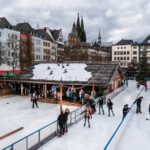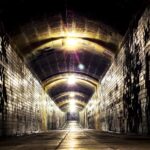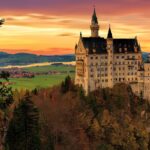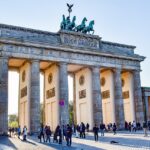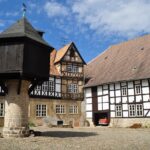 Cologne Cathedral (Kölner Dom) is a Roman Catholic cathedral in Cologne, Germany.
Cologne Cathedral (Kölner Dom) is a Roman Catholic cathedral in Cologne, Germany.
It is the seat of the Archbishop of Cologne and of the administration of the Archdiocese of Cologne.
It is a renowned monument of German Catholicism and Gothic architecture and was declared a UNESCO World Heritage Site in 1996.
Begun in 1248, the construction of this Gothic masterpiece took place in several stages and was not completed until 1880.
Over seven centuries, successive builders were inspired by the same faith and a spirit of absolute fidelity to the original plans.
The panorama of the city has been dominated by the Cathedral’s gigantic pair of towers since their completion in 1880.
The North Tower at 157.38 meters (516.33 feet) is 7 centimeters (2.75 inches) higher than the South Tower.
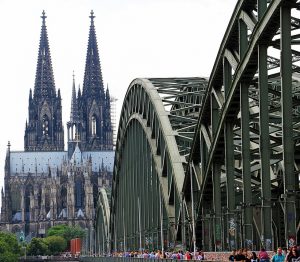 The Cathedral is still the second highest building in Cologne after the telecommunications tower. Its footprint is no less impressive, with the full length of the Cathedral measuring 145 meters (475 feet) and the cross nave 86 meters (282 feet) .
The Cathedral is still the second highest building in Cologne after the telecommunications tower. Its footprint is no less impressive, with the full length of the Cathedral measuring 145 meters (475 feet) and the cross nave 86 meters (282 feet) .
While the enormous Western facade is the largest in the world, the Cologne Cathedral has the world’s third largest church interior.
The cathedral covers almost 8,000 square meters (86,111 square feet) of floor space and can hold more than 20,000 people.
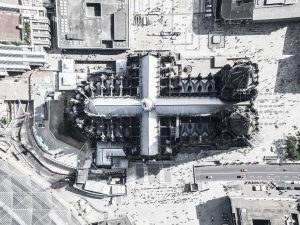 The design of Cologne Cathedral closely resembles that of Amiens Cathedral in terms of groundplan, style and the width to height proportion of the central nave.
The design of Cologne Cathedral closely resembles that of Amiens Cathedral in terms of groundplan, style and the width to height proportion of the central nave.
The plan is in the shape of a Latin Cross, as is usual with Gothic cathedrals.
The stone mass seems to rise, almost weightlessly, up to the 43 meters ( 141 feet) high baldachin-style arches.
The nave is enhanced by many nineteenth century stained-glass windows including a set of five on the south side called the “Bayernfenster” which were a gift from Ludwig I of Bavaria, a set highly representative of the painterly German style of that era.
 With no less than 104 seats, the medieval choir stalls in the inner choir of Cologne Cathedral are some of the largest of their kind still in existence.The choir is surrounded by 13th and 14th century art: carved oak stalls, frescoed walls, painted statues and stained glass.
With no less than 104 seats, the medieval choir stalls in the inner choir of Cologne Cathedral are some of the largest of their kind still in existence.The choir is surrounded by 13th and 14th century art: carved oak stalls, frescoed walls, painted statues and stained glass.
The Lady Chapel contains the Altar of the City Patrons, painted in 1442 by Stefan Lochner. The painting is notable for its photographic realism (note the varieties of herbs in the foreground) and believable depth.It is the most significant example of the Late Gothic Cologne school of painting.
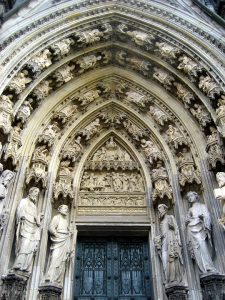 In the Sacrament Chapel is the Madonna of Milan, an elegant wooden sculpture depicting Mary and the child Jesus. Made in the Cologne Cathedral workshop around 1290, this High Gothic statue is associated with miracles and has attracted pilgrims for centuries.
In the Sacrament Chapel is the Madonna of Milan, an elegant wooden sculpture depicting Mary and the child Jesus. Made in the Cologne Cathedral workshop around 1290, this High Gothic statue is associated with miracles and has attracted pilgrims for centuries.
The Shrine of the Magi or the Shrine of the Three Kings is a reliquary said to contain the bones of the Biblical Magi, also known as the Three Kings or the Three Wise Men.It is the largest, most artistically significant, and, in terms of its content, most ambitious reliquary of the Middle Ages. The relics were brought to Cologne from Milan in 1164. From about 1190 to 1220 a number of artisans worked on the shrine in the workshop of the goldsmith Nicholas of Verdun and in workshops in Cologne and along the river Meuse that continued his work.
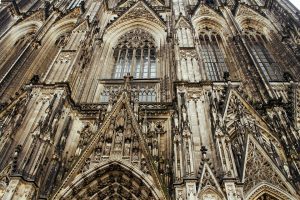 The Gero Cross or Gero Crucifix, of around 965–970, is the oldest large sculpture of the crucified Christ north of the Alps, and has always been displayed in Cologne Cathedral.
The Gero Cross or Gero Crucifix, of around 965–970, is the oldest large sculpture of the crucified Christ north of the Alps, and has always been displayed in Cologne Cathedral.
The cathedral has eleven church bells, four of which are medieval.
Cologne Cathedral has two pipe organs by Klais Orgelbau, the Transept Organ built in 1948 and the Nave Organ built in 1998.
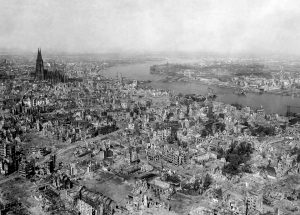 The Cologne Cathedral was the tallest building in the world between 1880 and 1884.
The Cologne Cathedral was the tallest building in the world between 1880 and 1884.
Cologne Cathedral was hit by 14 bombs during World War II, but the building did not fall.
In the present day, the Cathedral s a major pilgrimage place and millions of people visit the cathedral from all over the world.
Visitors can climb 509 stone steps of the spiral staircase to a viewing platform about 98 meters (322 feet) above the ground. The platform gives a scenic view over the Rhine.
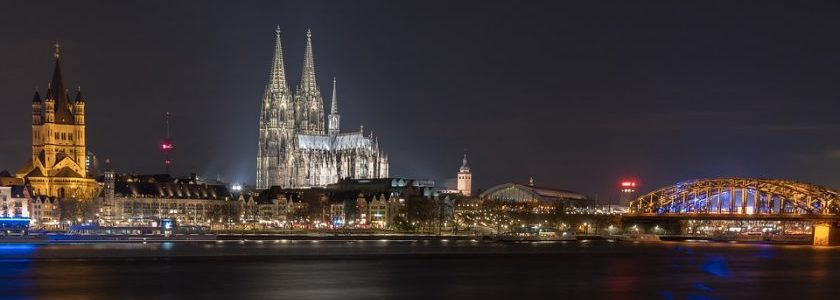
Related Articles:
Cologne Christmas market
